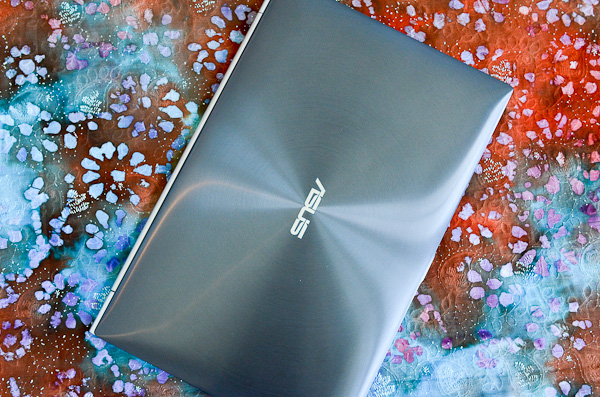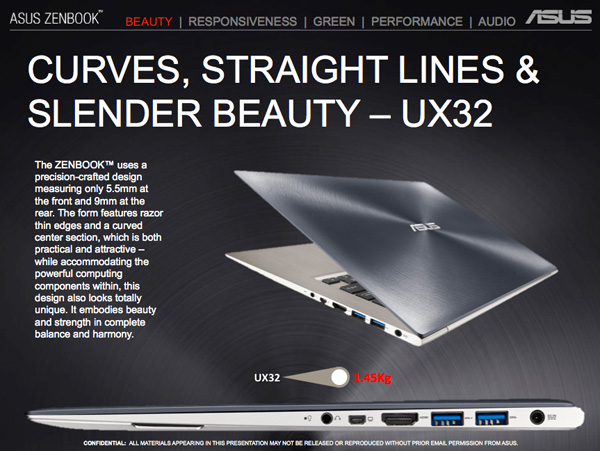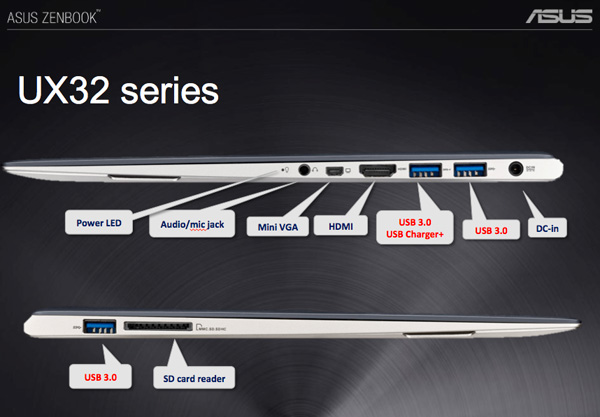ASUS Zenbook Prime (UX21A) Review: The First of the 2nd Gen Ultrabooks
by Anand Lal Shimpi on May 22, 2012 2:46 PM EST- Posted in
- Laptops
- CPUs
- Asus
- Ivy Bridge
- Zenbook
- Zenbook Prime
- Ultrabook
- Notebooks
The first round of Ultrabooks were mostly underwhelming. It shouldn't be a surprise, but many of the efforts were just half hearted at best. Of the companies who shipped the first Ultrabooks however, it was ASUS who came the closest to perfection with the Zenbook.
ASUS' Zenbook embodied the form factor, portability and overall concept of an Ultrabook. Where it failed to deliver was with its keyboard, display and, at least initially, with its trackpad. The first Zenbook was an amazing effort given the short period of time that it was conceived and developed in, but it was too rough around the edges.
Despite only being introduced 7 months ago, the Zenbook is old news. This is the Zenbook Prime:
The Zenbook Prime is ASUS' second generation Ultrabook, built around Ivy Bridge silicon. Unlike most silicon updates to notebooks however, the Zenbook Prime takes an almost Apple-like approach to renovating the tangibles rather than just relying on a faster chip to do the heavy lifting.
I don't know that I've ever seen a faster turn around on implementing reviewer and user feedback into a product. The Zenbook Prime fixes nearly every issue I had with the original Zenbook. From keyboard to display, it's all significantly better with the Zenbook Prime.
The circumstances around today's launch are a bit peculiar. Intel has an embargo in place on the as of yet unreleased Ivy Bridge CPUs, this applies to both notebooks and desktops. One such line of CPUs, the dual-core ultra-low-voltage Ivy Bridge parts that will find their way into many Ultrabooks, is covered by the aforementioned embargo. That embargo lifts at some point in the not too distant future, but ASUS wanted to have its review-ready hardware out the door and getting coverage before then. Why the urgency? It could have something to do with Apple's expected launch of updated MacBook Air and MacBook Pro systems. Rather than for Apple to get all the glory for being first, ASUS set some guidelines: we're allowed to talk about everything to do with the new Zenbook Primes, we just can't get into specifics on the CPU just yet. That's right, you won't read any model numbers, clock speeds or cache sizes here. Given what's already public about the ULV Ivy Bridge lineup I suspect this information isn't too hard to figure out if you're really motivated.

Zenbook Prime (left) vs. Zenbook (right)
The rest of the Zenbook Prime has nothing to do with Ivy Bridge. The form factor of the Zenbook Prime remains unchanged from its predecessor. Just like before we'll see two distinct models, an 11-inch (UX21) and 13-inch (UX31) in for review. With the lid closed, these two look identical to their Prime-less (composite numbered?) counterparts. ASUS sent the 11-inch Zenbook Prime in for review:
| ASUS Zenbook Prime Specs | |||||||||
| UX21A-DB5x | UX21A-DB7x | UX31A-DB51 | UX31A-DB52 | UX31A-DB71 | UX31A-DB72 | ||||
| CPU | ULV IVB | ULV IVB | ULV IVB | ULV IVB | ULV IVB | ULV IVB | |||
| GPU | HD 4000 | ||||||||
| Display | 11.6-inch 1920 x 1080 IPS | 13.3-inch 1920 x 1080 IPS | |||||||
| Memory | 4GB DDR3-1600 (on-board) | ||||||||
| Storage | 128GB U100 SSD | 128/256GB U100 SSD | 128GB U100 SSD | 256GB U100 SSD | |||||
| Wireless Connectivity | Intel Centrino N 6205, 802.11b/g/n 2.4/5GHz 2x2:2, Bluetooth 4.0 | ||||||||
| Battery | 35Wh | 50Wh | |||||||
| Camera | 720p front facing | ||||||||
| Audio | Bang and Olufsen ICEpower | ||||||||
| I/O | 2 x USB 3, 1x audio/mic, 1x microHDMI, 1x miniVGA | 2 x USB 3, 1 x audio/mic, 1 x microHDMI, 1 x miniVGA, 1 x SD Card reader | |||||||
| Dimensions | 299mm x 168.5mm x 3-9mm | 325mm x 223mm x 3-9mm | |||||||
| Weight | 1.1kg | 1.3kg | |||||||
| Price USD | TBD | TBD | $1099 | $1199 | $1499 | $1599 | |||
Pricing is still in the air as the Zenbook Prime won't be shipping until early June. I suspect much of how aggressive ASUS is on this front will depend on what Apple does in the coming weeks.
Introducing the UX32, Starting at $799
There's also a new member of the Zenbook Prime lineup, the 13-inch UX32. Featuring a thicker chassis, the UX32 will be offered as low as $799 with a 1366 x 768 TN panel, hard drive + SSD cache and as high as $1299 with a discrete NVIDIA GeForce GT 620M GPU:
| ASUS Zenbook Prime UX32 Specs | |||||||||
| UX32A-DB31 | UX32A-DB51 | UX32VD-DB71 | |||||||
| CPU | ULV IVB | ULV IVB | ULV IVB | ||||||
| GPU | HD 4000 | NVIDIA 620M + HD 4000 | |||||||
| Display | 13.3-inch 1366 x 768 TN | 13.3-inch 1920 x 1080 IPS | |||||||
| Memory | 2GB DDR3-1600 (on-board) + 2GB or 4GB SO-DIMM | ||||||||
| Storage | 7mm 320GB HDD + 24GB SSD (cache) | 7mm 500GB HDD + 24GB SSD (cache) | 7mm 500GB HDD + 24GB SSD (cache) | ||||||
| Wireless Connectivity | Intel Centrino N 6205, 802.11b/g/n 2.4/5GHz 2x2:2, Bluetooth 4.0 | ||||||||
| Battery | 48Wh | ||||||||
| Camera | 720p front facing | ||||||||
| Audio | Bang and Olufsen ICEpower | ||||||||
| I/O | 3 x USB 3, 1 x audio/mic, 1 x HDMI, 1 x miniVGA, 1 x SD card reader | ||||||||
| Dimensions | 325mm x 223mm x 5.5 - ~9mm | ||||||||
| Weight | 1.44kg | ||||||||
| Price USD | $799 | $999 | $1299 | ||||||
Depending on how well the SSD cache works, and how good the 1366 x 768 panel is, the $799 UX32A could be a very compelling system.













192 Comments
View All Comments
Paedric - Tuesday, May 22, 2012 - link
I don't know for virtual machines, but games are already barely playable even with reduced resolution.This is not a gaming system or workstation you know, this is web surf/ Facebook/other lightweight applications system; adding more RAM is basically useless and will only reduce battery life.
Judging by your comment, this is not the form factor you need, we're not there yet for gaming performance in a 11" ultrabook.
nortexoid - Tuesday, May 22, 2012 - link
Actually more RAM will in most cases improve battery life and performance since it can greatly reduce disk swapping. Fortunately the Zenbook has an SSD so performance won't suffer much from swapping, but if you have just a few apps open ( browser, Word, music player, etc.) that 4GB will go FAST.Manufacturers really need to start moving to 6GB default or else 2/4GB onboard plus a vacant DIMM slot.
puppies - Wednesday, May 23, 2012 - link
Rubbish rubbish rubbish. I have 4gb on my XPS 17, i've had 1GB dedicated to a minecraft server, had music playing, multiple office documents open, and multiple browser pages up and never even got close to maxing my RAM.I can only presume you don't understand how windows grabs way more RAM than it needs (2GBish) and releases it if another program requires it otherwise you are talking about having 20 doccuments and 20 web pages open while attempting to play a resource intensive game at the same time which would turn that low power enveloped CPU into a stuttering mess way before it touched the last 25% of the RAM.
Spathi - Wednesday, May 23, 2012 - link
He speaks the truth nortexoid,I have 16g in my desktop and it uses 12G and I imagine windows would use 6g of 8g and 3g of 4g. Mostly useless caching.
Memory actually uses lots of power (relative to the notebooks current use), so you don't really want to add more.
IMHO, this nb is designed as a gift/recommendation to your gf/wife/mother/aunty/dad. It is the sort of thing you can get them and steal on the holidays when bored, but won't be tempted to steal every day.
It would probably play enough fun games OK, just not the latest at high res. So also good for work/uni without getting carried away gaming. Most of the "latest" candy games are boring anyway after an hour, lol.
ImSpartacus - Wednesday, May 23, 2012 - link
That's not always true. I'm rolling with 8GB of RAM in my Win7 laptop and I've never seen the system use more than half of it. I'm usually around 2GB with Chrome (5-15 tabs), Word and PowerPoint open.Admittedly, my use case is light. However, that is "just a few apps open," yet 4GB has not gone "FAST".
Lucian Armasu - Tuesday, May 22, 2012 - link
Do you really think you're going to need more than 4GB of RAM with the type of GPU's ultrabooks are having?nortexoid - Tuesday, May 22, 2012 - link
Yes, if you don't want to quit all your open apps just to play a game.Sunburn74 - Tuesday, May 22, 2012 - link
Gaming isn't a major feature of this laptop. Its more of a happenstance.The power hit from the extra ram affects use when not gaming. The extra ram is only really useful for a few specific situations (situations which the laptop is not particularly designed for anyway).
seapeople - Saturday, May 26, 2012 - link
You realize that Windows has something called the Page File, right? And that this computer (and most ultrabooks) have a solid state drive?bhima - Wednesday, May 23, 2012 - link
For Graphic Designers on the go, this could be a pretty great machine with that nice monitor but 4GB of ram IS limiting when you are working with 3 adobe programs open and large, 300dpi files.